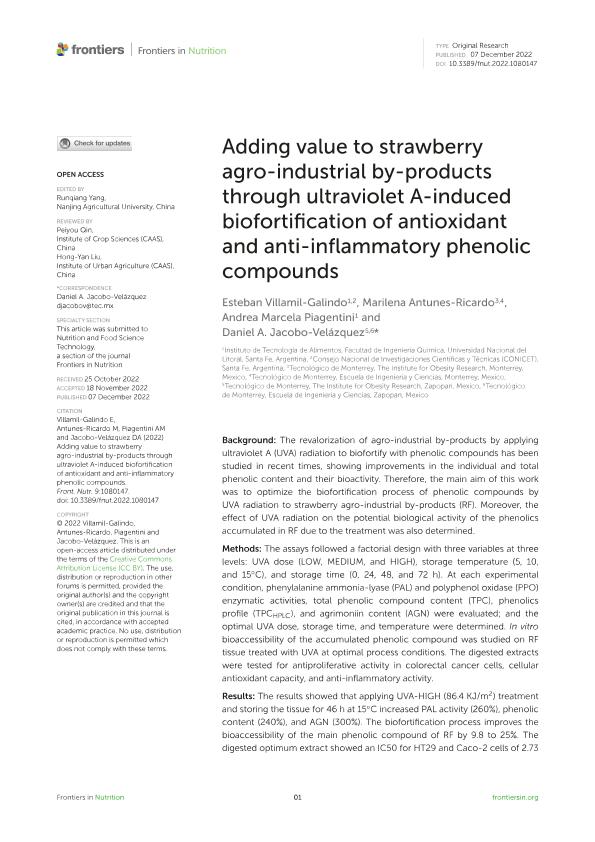Artículo
Adding value to strawberry agro-industrial by-products through ultraviolet A-induced biofortification of antioxidant and anti-inflammatory phenolic compounds
Villamil Galindo, Johan Esteban ; Antunes Ricardo, Marilena; Piagentini, Andrea; Jacobo Velázquez, Daniel A.
; Antunes Ricardo, Marilena; Piagentini, Andrea; Jacobo Velázquez, Daniel A.
 ; Antunes Ricardo, Marilena; Piagentini, Andrea; Jacobo Velázquez, Daniel A.
; Antunes Ricardo, Marilena; Piagentini, Andrea; Jacobo Velázquez, Daniel A.
Fecha de publicación:
12/2022
Editorial:
Frontiers Media
Revista:
Frontiers in Nutrition
ISSN:
2296-861X
Idioma:
Inglés
Tipo de recurso:
Artículo publicado
Clasificación temática:
Resumen
Background: The revalorization of agro-industrial by-products by applying ultraviolet A (UVA) radiation to biofortify with phenolic compounds has been studied in recent times, showing improvements in the individual and total phenolic content and their bioactivity. Therefore, the main aim of this work was to optimize the biofortification process of phenolic compounds by UVA radiation to strawberry agro-industrial by-products (RF). Moreover, the effect of UVA radiation on the potential biological activity of the phenolics accumulated in RF due to the treatment was also determined. Methods: The assays followed a factorial design with three variables at three levels: UVA dose (LOW, MEDIUM, and HIGH), storage temperature (5, 10, and 15°C), and storage time (0, 24, 48, and 72 h). At each experimental condition, phenylalanine ammonia-lyase (PAL) and polyphenol oxidase (PPO) enzymatic activities, total phenolic compound content (TPC), phenolics profile (TPCHPLC), and agrimoniin content (AGN) were evaluated; and the optimal UVA dose, storage time, and temperature were determined. In vitro bioaccessibility of the accumulated phenolic compound was studied on RF tissue treated with UVA at optimal process conditions. The digested extracts were tested for antiproliferative activity in colorectal cancer cells, cellular antioxidant capacity, and anti-inflammatory activity. Results: The results showed that applying UVA-HIGH (86.4 KJ/m2) treatment and storing the tissue for 46 h at 15°C increased PAL activity (260%), phenolic content (240%), and AGN (300%). The biofortification process improves the bioaccessibility of the main phenolic compound of RF by 9.8 to 25%. The digested optimum extract showed an IC50 for HT29 and Caco-2 cells of 2.73 and 5.43 μg/mL, respectively, and presented 60% cellular antioxidant capacity and 30% inhibition of NOX production. Conclusion: The RF treated with UVA is an excellent source of phenolic compounds; specifically, ellagitannins and the UVA radiation proved to be efficient in biofortify RF, significantly improving the phenolic compounds content and their bioactive properties with adequate bioaccessibility, adding value to the strawberry agro-industrial by-products.
Archivos asociados
Licencia
Identificadores
Colecciones
Articulos(CCT - SANTA FE)
Articulos de CTRO.CIENTIFICO TECNOL.CONICET - SANTA FE
Articulos de CTRO.CIENTIFICO TECNOL.CONICET - SANTA FE
Citación
Villamil Galindo, Johan Esteban; Antunes Ricardo, Marilena; Piagentini, Andrea; Jacobo Velázquez, Daniel A.; Adding value to strawberry agro-industrial by-products through ultraviolet A-induced biofortification of antioxidant and anti-inflammatory phenolic compounds; Frontiers Media; Frontiers in Nutrition; 9; 12-2022; 1-19
Compartir
Altmétricas



